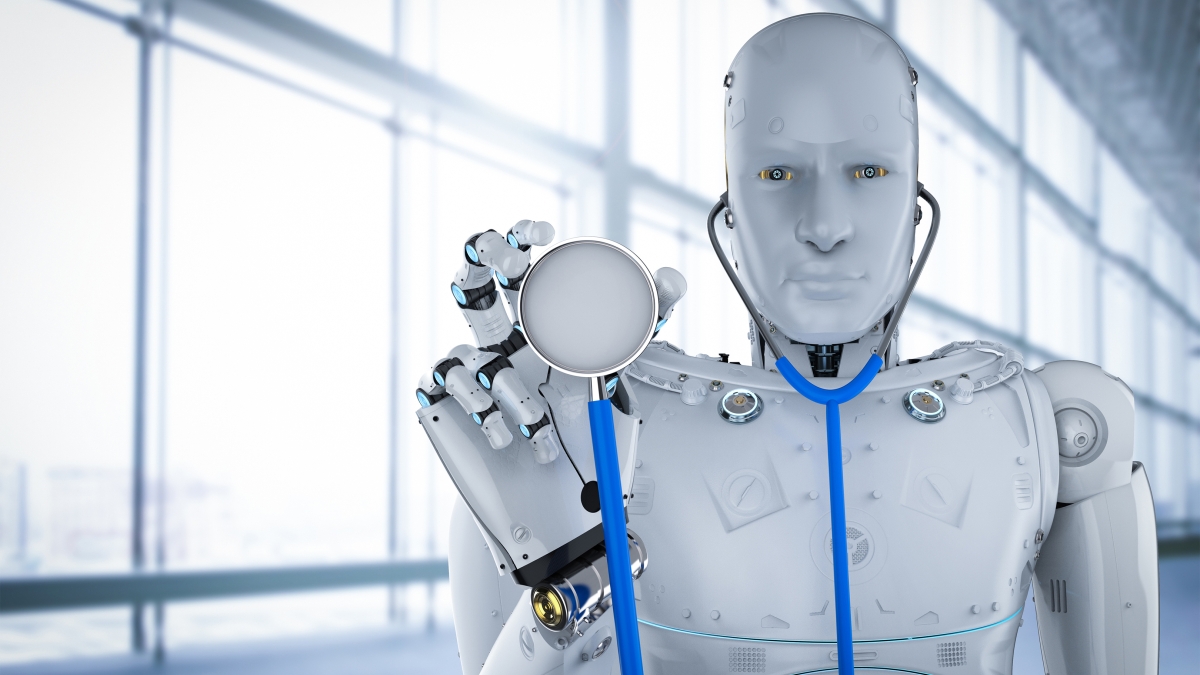These days, humans and robots are collaborating more and more in health care. That applies to almost every corner of the industry, and especially in the operating room.
But does that collaboration have a place in customer service and other medical-related processes?
Yes and no, according to a husband-and-wife research team at Arizona State University.
Martin Mende, a marketing professor at the W. P. Carey School of Business and the J. Willard and Alice S. Marriott Foundation Professor in Services Leadership, and Maura Scott, marketing professor and Edward M. Carson Chair in Services Marketing, recently co-authored an academic article with colleagues on the value of cobotic health care.
Cobotic health care allows robotic medical workers to perform tasks to free up doctors and nurses to monitor multiple patients simultaneously. The tasks include delivering prescriptions throughout the hospital, lifting and transporting patients, insurance claims inventory management, automated billing, scheduling and appointment reminders, and even conducting surgeries alongside physicians.
Titled “Cobotic Service Teams and Power Dynamics: Understanding and Mitigating Unintended Consequences of Human‑Robot Collaboration in Healthcare Services,” the paper examines how consumers react to these automated helpers in service roles.
ASU News spoke with Mende and Scott about their research and findings.
Question: What prompted this study?
Mende: Some people thought this research was prompted by my watching too much science fiction, such as “iRobot,” “West World” and “Frank and the Robot.” But actually, this work started about a decade ago when my co-authorsOther researchers involved in this paper include Jenny van Doorn, a professor at the University of Groningen, the Netherlands; Dhruv Grewal, a professor of marketing at Babson College; and Ilana Shanks at Stonybrook University. and I were tasked with anticipating how the marketplace would evolve over the next decade, specifically by thinking of how humans and technology would interact. The result was the introduction of a concept called “automated social presence” in which technology, such as a robot, makes consumers experience another social presence. This set the groundwork for a body of work that focuses on how technology, particularly robots, can affect all facets of our lives in the future.
At the same time, around the world, we are seeing customer-facing service robots in a variety of service industries like food service, hotels, airports and, of course, in health care. As you might expect, without careful research-based planning into how to optimize the introduction of service robots into the marketplace, people can find service robots to be a bit creepy.
From this foundation, Maura and I, along with our co-authors, have built a body of work around the questions: How do consumers react to robots in various service roles in the marketplace? And how can companies leverage robots to best serve consumers? In this particular project we are sharing today, we focus on how people respond to cobotic health care teams — that is, a team with both a human and a robot health care service provider.
Q: What were the key findings?
Scott: We conducted studies in different health care contexts, such as a fitness class in a senior-citizen home and a health consultation session for undergraduate students. We were interested in how people felt when they were served by a cobotic health care team, in which the leader was a robot and the assistant was a human — or vice versa.
We found that people preferred for the human to be in charge as the team leader. In fact, with a human-led cobotic team, study participants indicated a greater willingness to return to the health care provider and to spread positive word-of-mouth.
Q: What surprised you the most?
Mende: Further examination of the data uncovered that a key reason for the unfavorability toward the robot-led team had to do with how people perceived power dynamics when a robot was in charge. This made us think about how to increase the consumers’ feelings of power.
We then conducted another study with the same approach — human-robot teams, varying whether the human or the robot was the leader. But, we added to this study an option that could empower consumers. We gave people the option to choose which robot would serve them. This was a relatively small choice, choosing the color of the robot — gray, orange or blue — among otherwise identical robots. We found that people who were able to select their robot were more comfortable with a robot being in charge of the team, as compared to those who did not get to choose their robot.
Q: How do you believe the health care industry will respond to your findings?
Scott: These insights can provide numerous benefits to health care organizations. Health care organizations around the globe are grappling with a workforce shortage; at the same time, technological solutions are increasingly being used to supplement the important work of doctors, nurses, emergency service workers and other health care providers.
As these types of cobotic team solutions roll out, organizations need to understand how to deliver these offerings in a way that supports patients at a time when they are vulnerable — when they are seeking care. This is where our research can help.
Humans and robots each bring different skills to health care. In another study, we pointed out the specific reason the robot was leading the cobotic team, emphasizing that robots can screen for cancers more precisely and can process large amounts of data in seconds. As people understood the purpose of the robot’s role as team leader, they became more favorable toward the robot leading the cobotic team.
We found that people who were able to select their robot were more comfortable with a robot being in charge of the team ...
Maura ScottASU marketing professor
Q: Are these easy implementations and quickly actionable items, or will they take time?
Mende: From our research, some steps can be quite actionable for health care organizations. For instance, as patients transition into being served by cobotic teams, giving them the choice of paying to opt out may be a solution. In one study, we found that people were willing to pay more to “upgrade” to a human-only team to a greater degree when the team leader was a robot than when the team leader was a human. This suggests that providing a suite of options for patients may help with adoptions.
Q: How do you plan to continue this stream of research, and do you believe it has applications in other industries or fields?
Scott: We are continuing to build on this body of work to understand how the marketplace reacts to robot-human interfaces and interactions. We are currently studying how what we call "cyborgs" are perceived in the marketplace. That is, we are studying when humans wear or integrate technological enhancements to provide service to customers. Cyborgs can take many forms. This could be a physician using smart glasses to scan a patient’s real-time health vitals and simultaneously access past health records and data. It could also be an employee wearing a robotic exoskeleton for lifting tasks that would otherwise be impossible for one person to lift, such as a warehouse employee lifting a refrigerator or a nurse lifting a heavy patient.
Our research on cobotic teams, and human-technology interfaces in the marketplace more generally, has implications for many industries. We already see cobotic teams in hospitality services such as food service and hotels. We anticipate wider spread adoption in other industries such as retail and services. We are thrilled that we can do this important work at Arizona State University.
More Business and entrepreneurship
Sustainability leader and ASU alum honored for transforming business with a people-first approach
Long before Jim Fish ('86 BS in accountancy) became president and CEO of WM — formally Waste Management — in 2016, he recognized that the higher he climbed the corporate ladder, the greater the…

ASU business students take on the big leagues
Each year, sports fans from across the country flock to Arizona to attend major events like the Waste Management Phoenix Open, Fiesta Bowl and Cactus League Spring Training. These mega-events…

With help from ASU and a viral TikTok, an entrepreneur soars
Nearly five years ago, Ruben Trujillo saw his entrepreneurial dream slipping away as he wondered how he would pay his rent.Now, Trujillo’s business, Café Emporos, is featured on a national TV…



